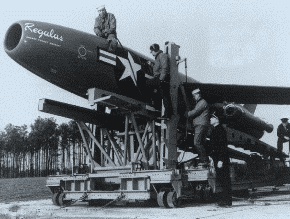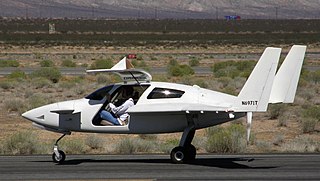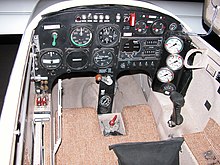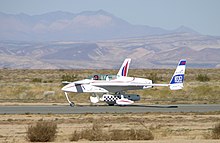
Scaled Composites is an American aerospace company founded by Burt Rutan and currently owned by Northrop Grumman. It is located at the Mojave Air and Space Port in Mojave, California, United States. Founded to develop experimental aircraft, the company now focuses on designing and developing concept craft and prototype fabrication processes for aircraft and other vehicles. It is known for unconventional designs, for its use of non-metal, composite materials, and for winning the Ansari X Prize with its experimental spacecraft SpaceShipOne.

The Rutan Model 76 Voyager was the first aircraft to fly around the world without stopping or refueling. It was piloted by Dick Rutan and Jeana Yeager. The flight took off from Edwards Air Force Base's 15,000 foot runway in the Mojave Desert on December 14, 1986, and ended 9 days, 3 minutes and 44 seconds later on December 23, setting a flight endurance record. The aircraft flew westbound 26,366 statute miles at an average altitude of 11,000 feet (3,350 m).

SpaceShipOne is an experimental air-launched rocket-powered aircraft with sub-orbital spaceflight capability at speeds of up to 3,000 ft/s (2,000 mph) / 910 m/s (3,300 km/h) using a hybrid rocket motor. The design features a unique "feathering" atmospheric reentry system where the rear half of the wing and the twin tail booms folds 70 degrees upward along a hinge running the length of the wing; this increases drag while retaining stability. SpaceShipOne completed the first crewed private spaceflight in 2004. That same year, it won the US$10 million Ansari X Prize and was immediately retired from active service. Its mother ship was named "White Knight". Both craft were developed and flown by Mojave Aerospace Ventures, which was a joint venture between Paul Allen and Scaled Composites, Burt Rutan's aviation company. Allen provided the funding of approximately US$25 million.

Elbert Leander "Burt" Rutan is a retired American aerospace engineer and entrepreneur noted for his originality in designing light, strong, unusual-looking, and energy-efficient air and space craft. He designed the record-breaking Voyager, which in 1986 was the first plane to fly around the world without stopping or refueling. He also designed the Virgin Atlantic GlobalFlyer, which in 2006 set the world record for the fastest and longest nonstop non-refueled circumnavigation flight in history. In 2004, Rutan's sub-orbital spaceplane design SpaceShipOne became the first privately funded spacecraft to enter the realm of space, winning the Ansari X-Prize that year for achieving the feat twice within a two-week period.

Richard Glenn Rutan was an American military aviator and officer, as well as a record-breaking test pilot who in 1986 piloted the Voyager aircraft on the first non-stop, non-refueled around-the-world flight with co-pilot Jeana Yeager. He was the older brother of famed aerospace designer Burt Rutan, whose many earlier original designs Dick piloted on class record-breaking flights, including Voyager.

Richard Alan "Rick" Searfoss was an American aviator who was United States Air Force colonel, NASA astronaut and test pilot.

The Mojave Air and Space Port at Rutan Field is in Mojave, California, United States, at an elevation of 2,801 feet (854 m). It is the first facility to be licensed in the United States for horizontal launches of reusable spacecraft, being certified as a spaceport by the Federal Aviation Administration on June 17, 2004. The facility covers 2,998 acres and has three runways.

The Rutan Model 61 Long-EZ is a tandem 2-seater homebuilt aircraft designed by Burt Rutan's Rutan Aircraft Factory. The Long-EZ has a canard layout, a swept wing with wingtip rudders, and a pusher engine and propeller. The tricycle landing gear has fixed main wheels with streamlined spats and a retractable nosewheel. Its predecessor was the VariEze, plans for which were first available to homebuilders in 1976. The prototype Long-EZ, N79RA, first flew on June 12, 1979.

The Rutan VariEze is a composite, canard aircraft designed by Burt Rutan. It is a high-performance homebuilt aircraft, hundreds of which have been constructed. The design later evolved into the Long-EZ and other, larger cabin canard aircraft. The VariEze is notable for popularizing the canard configuration and moldless glass cloth composite construction for homebuilt aircraft.

Rocket mail is the delivery of mail by rocket or missile. The rocket lands by deploying an internal parachute upon arrival. It has been attempted by various organizations in many countries, with varying levels of success. It has never become widely seen as being a viable option for delivering mail, due to the cost of the schemes and numerous failures.

XCOR Aerospace was an American private spaceflight and rocket engine development company based at the Mojave Air and Space Port in Mojave, California, Midland International Air and Spaceport in Midland, Texas and the Amsterdam area, the Netherlands. XCOR was formed in 1999 by former members of the Rotary Rocket rocket engine development team, and ceased operations in 2017.

The Rocket Racing League was a racing league that planned to use rocket-powered aircraft to race a closed-circuit air racetrack. Founded in 2005, the league made its first public flights in 2010 and was working to begin regular racing seasons. The "Rocket Racers" were slated to compete in the air and on a virtual racetrack easily viewed by a live audience as well as projected on large screen and handheld electronic displays.

The Velocity Model 173 SE (Standard Elite) is an entry-level canard pusher aircraft from Velocity Aircraft. The four seat, rear engine aircraft may be powered by a 160 hp (120 kW) Lycoming IO-320 or a 200 hp (150 kW) Lycoming IO-360 engine.
Pioneer Rocketplane was an aerospace design and development company intent on developing affordable crewed space flight. The company is most famous for advocating a horizontal takeoff, turbo-jet and rocket propelled, aerial-refueled, rocket plane concept called the Pathfinder. The company still exists, but is no longer in operation. Pioneer's intellectual property is now owned by Rocketplane Limited, Inc., however Rocketplane Limited does not employ any of the principals of Pioneer Rocketplane.

The AMSOIL Racer, also known as the Rutan Biplane Racer and the Rutan Model 68 Racer, was a race tandem wing plane which was designed by Burt Rutan's Rutan Aircraft Factory, and built and flown by Dan Mortensen. It set several speed records, but crashed at the 1983 Reno Air Races.

The XCOR Lynx was a proposed suborbital horizontal-takeoff, horizontal-landing (HTHL), rocket-powered spaceplane that was under development by the California-based company XCOR Aerospace to compete in the emerging suborbital spaceflight market. The Lynx was intended to carry one pilot, a ticketed passenger, and/or a payload above 100 kilometres (62 mi) altitude. The concept has been under development since 2003 when a two-person suborbital spaceplane was announced under the name Xerus.

Air-launch-to-orbit (ALTO) is the method of launching smaller rockets at altitude from a heavier conventional horizontal-takeoff aircraft, to carry satellites to low Earth orbit. It is a follow-on development of air launches of experimental aircraft that began in the late 1940s. This method, when employed for orbital payload insertion, presents significant advantages over conventional vertical rocket launches, particularly because of the reduced mass, thrust, cost of the rocket, geographical factors, and natural disasters.

The Scaled Composites Model 81 Catbird is a high-efficiency five-seat single-engine all-composite general aviation aircraft designed by Burt Rutan. It is unusual in that it incorporates both a small forward wing and a small conventional horizontal stabilizer on the tail.

RocketShip Tours is an American space tourism company founded in 2008 by travel industry entrepreneur Jules Klar and which planned to provide sub-orbital human spaceflights to the paying public, in partnership with rocketplane developer XCOR Aerospace. Klar created RocketShip Tours to act as General Sales Agent for XCOR Aerospace.
Aircraft have different ways to take off and land. Conventional airplanes accelerate along the ground until reaching a speed that is sufficient for the airplane to takeoff and climb at a safe speed. Some airplanes can take off at low speed, this being a short takeoff. Some aircraft such as helicopters and Harrier jump jets can take off and land vertically. Rockets also usually take off vertically, but some designs can land horizontally.






















